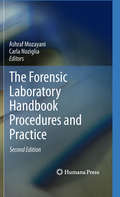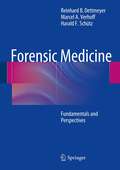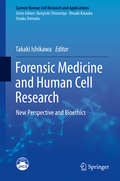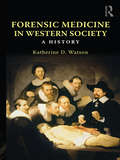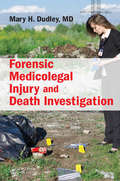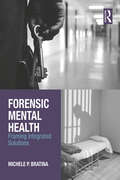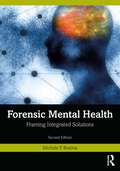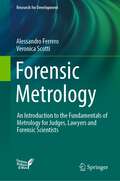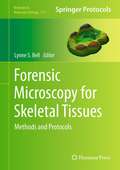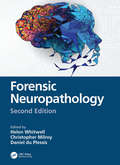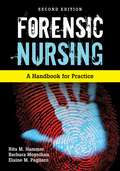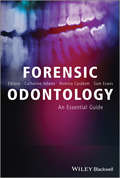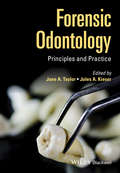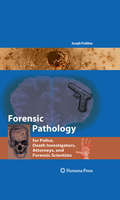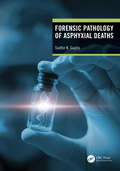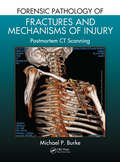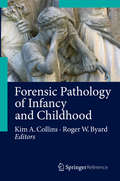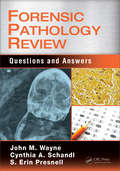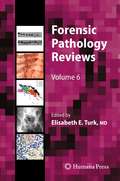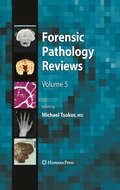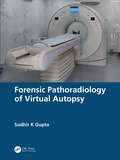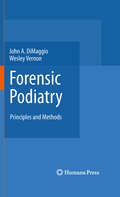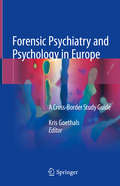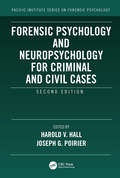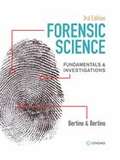- Table View
- List View
The Forensic Laboratory Handbook Procedures and Practice
by Ashraf Mozayani Carla NozigliaForensic science has come a long way in the past ten years. It is much more in-depth and much broader in scope, and the information gleaned from any evidence yields so much more information than it had in the past because of incredible advances in analytic instruments and crucial procedures at both the crime scene and in the lab. Many practices have gone digital, a concept not even fathomed ten years ago. And from the first collection of evidence to its lab analysis and interpretation to its final presentation in court, ethics has become an overriding guiding principle. That's why this new edition of this classic handbook is indispensable. The Forensic Laboratory Handbook Procedures and Practice includes thirteen new chapters written by real-life practitioners who are experts in the field. It covers the tried and true topics of fingerprints, trace evidence, chemistry, biology, explosives and arson, forensic anthropology, forensic pathology, forensic documents, firearms and toolmarks. This text also addresses an array of new topics including accreditation, certification, ethics, and how insects and bugs can assist in determining many facts including a margin of time of death. In the attempt to offer a complete and comprehensive analysis The Forensic Laboratory Handbook Procedures and Practice also includes a chapter discussing the design of a laboratory. In addition, each chapter contains educational requirements needed for the discipline it covers. Complete with questions at the end of each chapter, brief author bios and real crime scene photos, this text has risen to greet the many new challenges and issues that face today's forensic crime practitioners.
Forensic Medicine
by Reinhard B. Dettmeyer Marcel A. Verhoff Harald F. SchützThis book presents the latest developments in the field of forensic pathology/forensic medicine, including important advances in forensic histopathology, forensic radiology, medical malpractice, understanding of child abuse, and forensic toxicology. Various forms of trauma are addressed in individual chapters, and among the other topics covered are traffic medicine, forensic alcohol toxicology, forensic DNA analysis, forensic osteology, and international regulations. The book includes a wealth of color illustrations and numerous tables presenting key facts. The authors are leading experts in general pathology, forensic radiology, and forensic toxicology. Forensic Pathology/Forensic Medicine: Fundamentals and Perspectives will be of interest not only to specialist pathologists and those working in forensic medicine, but also to coroners, forensic physicians, students, lawyers, attorneys, and policemen.
Forensic Medicine and Human Cell Research: New Perspective And Bioethics (Current Human Cell Research And Applications Ser.)
by Takaki IshikawaThis volume reviews the application of biochemical and molecular pathologies, which are based on conventional pathomorphology, toxicology, and DNA analysis technologies, not only to autopsies but also to the field of clinical medicine in general. The systematic and integrated use of biochemical, immmunohistochemical, and molecular pathology, toxicology, DNA analysis, and cell culture investigations reinforces the pathophysiological diagnostic criteria in a forensic autopsy for clinical diagnosis. The use of these technologies can help to determine the cause and process of death and characterize the functional pathophysiological changes in the body that occur during the death process. Recently, the systematization of the latest supplemental tests, diagnostic methods, and quality control has allowed us to conduct comprehensive data collection and analysis for a range of diseases. This book presents the latest findings on the pathology of a broad range of human diseases, based on data concerning postmortem biochemistry and molecular biology collected from approximately 1000 people. Further, it puts forward a code of ethics for undertaking pathophysiological research and describes research techniques for uncovering pathophysiological mechanisms. As such, it offers a unique resource for researchers in the field of forensic medicine and pathology, and for clinicians.
Forensic Medicine in Western Society: A History
by Katherine D. WatsonThe first book of its kind, Forensic Medicine in Western Society: A History draws on the most recent developments in the historiography, to provide an overview of the history of forensic medicine in the West from the medieval period to the present day. Taking an international, comparative perspective on the changing nature of the relationship between medicine, law and society, it examines the growth of medico-legal ideas, institutions and practices in Britain, Europe (principally France, Italy and Germany) and the United States. Following a thematic structure within a broad chronological framework, the book focuses on practitioners, the development of notions of ‘expertise’ and the rise of the expert, the main areas of the criminal law to which forensic medicine contributed, medical attitudes towards the victims and perpetrators of crime, and the wider influences such attitudes had. It thus develops an understanding of how medicine has played an active part in shaping legal, political and social change. Including case studies which provide a narrative context to tie forensic medicine to the societies in which it was practiced, and a further reading section at the end of each chapter, Katherine D. Watson creates a vivid portrait of a topic of relevance to social historians and students of the history of medicine, law and crime.
Forensic Medicolegal Injury and Death Investigation
by Mary H. Dudley, M.D.Introducing the basic concepts of clinical forensic medicine and death investigation, this book covers the main areas of forensic investigation . It provides an introduction to forensic science and coverage of injury patterns, natural disease, accidental trauma, child injury and fatalities, and domestic violence. Anyone who has direct contact with death, crime, and the medicolegal system, including nurses, physicians, attorneys, death investigators, forensic pathologists, and police detectives, will find this an invaluable reference.
Forensic Mental Health: Framing Integrated Solutions
by Michele P. BratinaForensic Mental Health: Framing Integrated Solutions describes a criminal justice–mental health nexus that touches every population—juvenile and adult male and female offenders, probationers and parolees, the aging adult prison population, and victims of crime. In the United States today, the criminal justice system functions as a mental health provider, but at great cost to society. The author summarizes the historical roots of this crisis and provides an overview of mental illness and symptoms, using graphics to illustrate the most prevalent disorders encountered by police and other first responders. Bratina demonstrates in detail how the Sequential Intercept Model (SIM) supports integration of the U.S. healthcare and justice systems to offer more positive outcomes for offenders with mental illness. This book takes a multidisciplinary approach, addressing social work, psychology, counseling, and special education, and covers developments such as case-law related to the right to treatment and trauma-informed care. Designed for advanced undergraduates, this text also serves as a training resource for practitioners working with the many affected justice-involved individuals with mental illness, including juveniles, veterans, and substance abusers.
Forensic Mental Health: Framing Integrated Solutions
by Michele P. BratinaIn this book author Michele P. Bratina demonstrates how the Sequential Intercept Model (SIM) supports integration of the U.S. healthcare and justice systems to offer more positive outcomes for offenders with mental illness. The book describes a criminal justice–mental health nexus that touches every population—juvenile and adult male and female offenders, probationers and parolees, the aging adult prison population, and victims of crime. In the United States today, the criminal justice system functions as a mental health provider, but at great cost to society. The author summarizes the historical roots of this crisis and provides an overview of mental illness and symptoms, using graphics, case studies, and spotlight features to illustrate the most pressing issues encountered by justice and behavioral health professionals and the populations they serve. Forensic Mental Health takes a multidisciplinary approach, addressing social work, psychology, counseling, and special education, and covers developments such as case law related to the right to treatment and trauma-informed care. Designed for advanced undergraduates, this text also serves as a training resource for practitioners working with the many affected justice-involved individuals with mental illness and co-occurring substance use disorders, including juveniles and veterans.
Forensic Metrology: An Introduction to the Fundamentals of Metrology for Judges, Lawyers and Forensic Scientists (Research for Development)
by Alessandro Ferrero Veronica ScottiThis book offers up-to-date information and guidance on the application of metrology in legal proceedings, clarifying the limits of validity of scientific evidence and presenting an illuminating series of case studies in which measurement uncertainty has played an important role. The fundamental concepts of metrology are discussed, and it is explained how metrology is capable of quantifying the reliability of measurement results and thereby contributing to appropriate decision making. With the aid of the presented case studies, this book will assist readers in understanding how legal decisions should be made in the presence of uncertainty. Areas covered in those studies include breath alcohol concentration analysis, and DNA profiling. Nowadays, decisions in most legal cases are based on evidence obtained through scientific analysis involving the acquisition of accurate measurements. Against this background, Forensic Metrology will be of value for lawyers and judges in both civil and common law countries, as well as engineers and other scientists with an interest in the subject.
Forensic Microscopy for Skeletal Tissues
by Lynne S. BellForensic anthropology deals with human remains usually in the skeletonized form. The application of microscopy to skeletal tissues is well established and used routinely in biomedical science. Its adaptation to forensic questions is an increasing area of interest, and publications utilizing microscopy have increased in the scientific literature. In Forensic Microscopy for Skeletal Tissues: Methods and Protocols, expert researchers in the forensic, archeological and paleontological disciplines, and detail many of the methods which are now commonly used to study skeletal material. These methods include differing forms of light, confocal, scanning electron and transmission electron microscopy. Written in the highly successful Methods in Molecular BiologyTM series format, chapters include introductions to their respective topics, lists of the necessary materials and reagents, step-by-step, readily reproducible laboratory protocols, and key tips on troubleshooting and avoiding known pitfalls. Authoritative and practical, Forensic Microscopy for Skeletal Tissues: Methods and Protocols bring together differing forms of microscopy that are used in association with forensic anthropology, or have relevance to questions concerning forensic anthropology.
Forensic Neuropathology
by Helen Whitwell Christopher Milroy Daniel Du PlessisForensic neuropathology is an important specialty within forensic pathology. In addition to traumatic brain injury in the adult and child, forensic neuropathologists must also consider the role of natural disease within the forensic setting such as cerebrovascular disease, as well as neurotoxicology. Focusing on difficulties that arise in the medico-legal context, the chapters include techniques for the post-mortem examination of the brain and related structures. Forensic pathologists, neuropathologists, general pathologists, clinical forensic specialists as well as neuroscientists, neurologists and neurosurgeons will all find useful information. In addition, members of the legal profession have found this an important reference work. Chapters have been extensively revised and new content includes - Chronic traumatic encephalopathy-related pathology - Sudden unexplained death in epilepsy - Biomechanics of head injury - Updates on pathological aspects of head injury including infant head injury with ocular pathology - Clinical aspects of head injury and spinal injury including a new chapter on neuroradiology Reviews of the First Edition This outstanding book is unique. Well-illustrated with high-quality colour photographs and line drawings, it reads well. Strongly recommended for trainees in histopathology, neuropathology, paediatric pathology, and forensic pathology, as well as for consultants practising in these fields.
Forensic Nursing: A Handbook for Practice
by Rita Hammer Barbara Moynihan Elaine M. PagliaroDeveloped within a holistic, caring framework, and well grounded in theory and research, the Second Edition continues to provide a unique and comprehensive look at forensic nursing from an interdisciplinary perspective, and addresses the need for collaborative practice and skill in caring for victims of violence and disaster, as well as in competently assisting in investigations. New information has been included on human trafficking, sexual predators and the internet, and elder abuse.
Forensic Odontology
by Sam Evans Romina Carabott Catherine AdamsAn accessible, essential introduction to forensic odontology. Written by a team of well-established, active practitioners in the field, Forensic Odontology is invaluable for those needing an introduction to the subject for the general dental practitioner who has an interest in forensic dentistry and is contemplating practicing in the field. It will also be useful as a reference during practice. After a brief introduction the book covers dental anatomy and development, expert witness skills, mortuary practice, dental human identification, disaster victim identification, dental age assessment, bite marks, forensic photography and the role of the forensic odontologist in protection of the vulnerable person. Chapters outline accepted and recommended practices and refer to particular methodologies, presenting different schools of thought objectively.
Forensic Odontology
by Jane Taylor Jules KieserForensic odontology refers to the science and practice of dentistry which may be applied to help solve litigation in both criminal and civil cases. It is a specialist branch of dentistry that assists the legal system in the handling, analysis and interpretation of dental evidence.Forensic Odontology: Principles and Practice pulls together the very latest research findings and advice on best practice and essential skills, including aspects of forensic science that provide a well-rounded educational experience for the reader. Chapters provide coverage of anatomy and morphology, mortuary techniques, physical anthropology, applied forensic sciences, child and elder abuse, and facial approximation. The text introduces the various topics and discusses underpinning philosophies without being an exhaustive historical treatise. Appropriate case studies are used to highlight issues, and references to current research are provided to stimulate further reading and research.Written by experienced practitioners in the field, this informative introductory text is invaluable to graduate and undergraduate students, as well as experienced dentists, wishing to gain experience or pursue a career in forensic odontology. This text will be a welcome addition to the forensic odontological libraries of all practicing forensic odontologists.
Forensic Pathology for Police, Death Investigators, Attorneys, and Forensic Scientists
by Joseph A. PrahlowForensic Pathology for Police, Death Investigators, Attorneys, and Forensic Scientists is a forensic pathology book specifically written for professionals who interact with forensic pathologists. The book includes sections that address various general topics which are not normally present in the typical forensic pathology text, such as descriptions of medical, pathology and forensic pathology training, basic anatomy and physiology, an overview of other forensic science disciplines, and autopsy performance. Forensic Pathology for Police, Death Investigators, Attorneys, and Forensic Scientists also covers classic topics in forensic pathology, including death investigation, death certification, postmortem changes, and the entire range of case types, ranging from natural deaths to drug-related deaths to various types of violent death. The text is written in easy-to-understand language, and is complemented by hundreds of high-quality photographs.
Forensic Pathology of Asphyxial Deaths
by Sudhir K GuptaThis book provides an overview of Asphyxial Deaths which includes hanging, strangulation, choking, smothering, gagging, drowning, aspiration, mechanical and chemical asphyxiants, etc. Postmortem examination often leads to doubts as a clear distinction between the different type of asphyxia cannot be made easily. Forensic and physiological aspects are discussed with the help of illustrative cases. The author discusses the different aspects of asphyxia deaths and substantiates multiple case studies to establish a scientific approach that can act as a guideline to the autopsy surgeon in providing a precise opinion and clarify doubts for the judiciary involved in such criminal justice cases. Key Features• Presents individual case studies of Asphyxial deaths. • Covers the guidelines to be followed by the autopsy surgeons in different cases.• Discusses the physiological aspects of Asphyxial deaths in detail.• Illustrates the cases in a stepwise manner with more than 350 colored photographs of postmortem examination.
Forensic Pathology of Fractures and Mechanisms of Injury: Postmortem CT Scanning
by Michael P. BurkePractitioners of forensic medicine have various tools at their disposal to determine cause of death, and today‘s computed tomography (CT) can provide valuable clues if images are interpreted properly. This volume is a guide for the forensic pathologist who wants to use CT imaging to assist in determining the mechanism of injury that might have contributed to death. Enhanced with hundreds of CT images that clarify the text and case studies to put the material in context, the book gives a head-to-toe catalogue of various injuries and how they are represented on a CT scan.
Forensic Pathology of Infancy and Childhood
by Kim A. Collins Roger W. ByardThe investigation of sudden or unexplained death of children represents a unique medical and forensic area of study. Children have unique anatomic and functional characteristics that must be recognized and understood by the medical investigator. Further complicating this process is the fact that the anatomic structure, composition and function of various organs and organ systems in the pediatric population change throughout the developmental stages of childhood. The disease processes, reactions to trauma and risk factors for accidental death and homicide change from infancy through adolescence. "Forensic Pathology of Infancy and Childhood" provides an authoritative, comprehensive reference text devoted to the medicolegal investigation of sudden unexpected death in children. With contributions from internationally renowned experts, individual chapters focus on specific unique causes and organ systems with detailed accounts of the changes in fatal diseases, risk factors of causes of sudden death, and responses to fatal trauma that occur as a child grows from neonatal stage through infancy, toddlerhood, childhood and adolescence. This text is an essential reference resource for forensic pathologists, medical examiner offices, pediatric pathologists, pediatric hospitals, anatomic pathologists and those in training as well as those in related legal professions. "
Forensic Pathology Review: Questions and Answers
by John Wayne Md Cynthia Schandl S. PresnellThis book is an invaluable tool for studying and reviewing key concepts in forensic pathology. Written in a question-and-answer format, this accessible guide tests readers' knowledge of manner of death, patterns of injury, lab data interpretation, postmortem radiography and imaging, and much more. Over 300 questions, more than half with visual examples, cover both common and more unusual examples of forensic pathology seen in practice. A great resource for preparing for examinations including the American Board of Pathology examination. It provides answers with explanatory rationales for both correct and incorrect answers.
Forensic Pathology Reviews
by Elisabeth E. TurkFresh research has opened up new vistas in forensic pathology that are allowing for closer national and international cooperation between pathologists and scientists in a range of medical and scientific disciplines. At the same time, autopsy and laboratory techniques are undergoing rapid evolution, with new procedures coming on stream while existing processes yield additional--and more accurate--results. This sixth volume of reviews in forensic pathology provides professionals working in the field with cutting-edge material on the latest key advances in the fields of traumatic death, sudden natural death and death time estimation. Now with numerous color illustrations, the book gives forensic experts across the world a fully up-to-date guide to contemporary procedures and theory in forensic science and medicine. The chapters cover an exhaustive range of aspects in the discipline, from the analysis of sudden natural deaths in infancy and childhood to the cardiac proteomics approach in the study of cases involving sudden cardiac death. Other specialist chapters deal with the forensic investigation of deaths in aviation and as a result of accidents involving all-terrain vehicles. The volume covers fresh research in the use of protein markers for the estimation of post-mortem intervals, and features a chapter telling the story of the medico-legal investigation into the deaths resulting from the 9-11 terrorist attacks on the World Trade Center. Comprehensive and current, this fresh volume of reviews is an essential resource for professionals who need to stay ahead of the game in a fast-moving and exciting field of scientific endeavor.
Forensic Pathology Reviews 5
by Michael TsokosIn this new volume of the globally recognized Forensic Pathology Reviews, Dr. Michael Tsokos has gathered chapters from the top experts in the field to reveal both the applied and scientific areas of expertise along the broad spectrum of forensics studies. Volume 5 piques the mind as leading forensic pathologists from the United States and around the world offer advanced insight into death caused environmental conditions, trauma, neuropathology, natural causes, and ballistics. The authors of this volume further their exploration as they impart research related to identification, serial murder, histopathology, and age estimation. While unveiling unsurpassed and cutting-edge knowledge, Forensic Pathology Reviews, Volume 5 will also inspire emerging forensic scientists to immerse themselves in innovative research.
Forensic Pathoradiology of Virtual Autopsy
by Sudhir K GuptaVirtual autopsy is a burgeoning field that employs imaging methods to find the cause of death. This book critically analyses and compares different post-mortem features and their radiological appearance in diverse cases. It orients the forensic doctors trained in traditional autopsy to understand the radiological appearance of their gross findings and the radiologists to comprehend the pathology in an imaging study. Further, it provides the standard operating protocols to be followed in different cases. This can be an alternative to standard autopsies for broad and systemic examination of the whole body as it saves time, aids better diagnosis, and respects religious sentiments. Key features: Provides the reader with an in-depth review of the value of a CT-directed virtual autopsy complementing a regular autopsy and how it can enhance the quality of medico-legal death investigation in a jurisdiction. Bridges the gap between the specialities of Forensic Medicine and Radiology and helps the readers co-relate and understand the concept of Virtual Autopsy. Features over 500 original autopsy photographs and CT images with over 100 case reports including a stepwise approach to each case along with comparative radiological images.
Forensic Podiatry
by John A. Dimaggio Wesley Vernon ObeThe human foot is a complex body part composed of fifty-two bones, which is twenty-five percent of all the bones in the body. Nonetheless, the foot is often viewed by the public and doctors as a "minor" body part. Similarly, the importance of pedal evidence in crime investigation has also long been undervalued, but as footwear evidence has become more commonly used in forensic situations, so has pedal evidence, which is why this seminal work is so important: it is the first textbook ever dedicated to forensic podiatry. Forensic Podiatry is an international compilation of current practices authored by the pioneers in the field. Part I discusses general forensic concerns, including those at the crime scene, from an informative perspective. It covers tasks performed by the crime laboratory, forensic podiatry principles, and various aspects of human identification. Part II deals with specific forensic podiatric concerns such as photographic techniques, bare footprint identification, and footwear examination and analysis. It also discusses forensic gate and analysis as well as the identification of pedal remains from podiatry records, which is important for mass disaster scenes. Part III presents actual forensic podiatry case studies from the United Kingdom and the United States, and Part IV focuses on podiatry practice standards, which in many instances parallel expert witness responsibilities. Groundbreaking and essential, this book is useful for medical and criminal justice students as well as podiatrists, criminalists, footwear examiners, forensic anthropologists, attorneys and investigators.
Forensic Psychiatry and Psychology in Europe: A Cross-border Study Guide
by Kris GoethalsThis study guide aims to make European trainees in forensic psychiatry and psychology and young forensic psychiatrists and psychologists aware of the differences and commonalities in forensic psychiatry and psychology in different countries within Europe and to enable them to learn from the approaches adopted in each country. The guide is divided into five main sections that address legal frameworks, service provision and frameworks, mandatory skills, teaching and training in forensic psychiatry and psychology, and capita selecta. In addition, recommendations are made with respect to the practice of teaching and training across European countries. It is anticipated that the guide will provide an excellent means of improving specific skills and that, by learning about the offender/patient pathways in the different jurisdictions of Europe, the reader will gain a deeper understanding of the principles that govern methods and practices in their own work with mentally disordered offenders.
Forensic Psychology and Neuropsychology for Criminal and Civil Cases (Pacific Institute Series on Forensic Psychology)
by Harold V. Hall and Joseph G. PoirierToday's increasingly sophisticated psychological and neuropsychological assessments allow for a greater understanding, and improved evaluations, in forensic psychology. By integrating discussions of modern psychological and neuropsychological tests, with extant civil and criminal cases, Forensic Psychology and Neuropsychology for Criminal and Civil Cases, Second Edition serves as a fully-updated, professional resource outlining modern behavioral science’s impact on the legal system. This second edition synthesizes the theoretical, empirical, and clinical literature, examining it through the lens of case application. The book is divided into three parts to look at foundational legal, ethical and applied issues; criminal forensic evaluations; and civil forensic evaluations. Chapters new to this edition address substance abuse and intoxication, interviewing and interrogation, criminal profiling, faked amnesia and recall skills, post-concussive syndrome (PCS), post-traumatic stress disorder (PTSD), and trends and research directions. Clinicians, researchers and psychologists practicing in any number of related fields will be able to address relevant questions from both criminal-forensic and civil-forensic perspectives. Key features: Presents the latest advances in methodology and technology to assist forensic professional in assessment and case formulation in the search for ground truth in applied settings Outlines base rates for forensic areas of concern, especially helpful in evaluation, report writing and courtroom testimony as an expert witness Addresses complex criminal issues such as competency to stand trial, criminal responsibility, mitigating defenses, and violence risk Forensic Psychology and Neuropsychology for Criminal and Civil Cases, Second Edition is an invaluable resource to clinicians, experts witnesses, and legal professionals—a helpful adjunct for mental health experts to formulate sound direct and cross-examination strategies, and eliciting suggestions for forensically-related treatment and intervention.
Forensic Science: Fundamentals and Investigations
by Anthony J. Bertino Patricia Nolan BertinoWith popular television programs, movies, and books about criminal justice and crime scene investigation, students often have a passion for exploring forensic science. <p><p> Now that excitement can be guided into valuable learning experiences with the help of Forensic Science: Fundamentals & Investigations, 3e. This dynamic, visually powerful text has been carefully crafted to ensure solid scientific content and an approach that delivers precisely what is needed for high school courses. <p><p> Now an established best-seller, Forensic Science: Fundamentals & Investigations offers a truly experiential approach that engages students in active learning and emphasizes the application of integrated science. Student materials combine math, chemistry, biology, physics, and earth science with content aligned to the Next Generation Science Standards. <p><p> Capstone projects integrate the concepts learned throughout the text. Comprehensive, time-saving teacher support and lab activities deliver exactly what is needed to ensure that students receive a solid, integrated science education that keeps readers engaged at all learning levels. <p><p> Supported by MindTap with an eBook, online assessments, Interactive Labs, and Virtual Labs, students learn content and practice skills like real forensic scientists.
